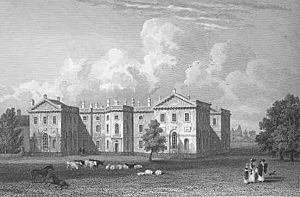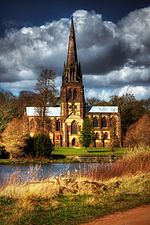Clumber Park facts for kids
Quick facts for kids Clumber Park |
|
|---|---|

The Lime Tree Avenue at Clumber Park, the longest of its kind in Europe. Planted in 1840, 2 miles long with 1,296 common limes (Tilia x europaea)
|
|
| Lua error in Module:Location_map at line 420: attempt to index field 'wikibase' (a nil value). | |
| Location | Worksop, Nottinghamshire, England |
| Nearest city | Nottingham |
| OS grid | SK625755 |
| Area | 1,537 hectares (3,800 acres) |
| Operated by | National Trust |
| Visitors | 666,997 (2019) |
| Open | Park: 7.00am to dusk. Other facilities have more restricted times. |
| Status | SSSI (for map see Map) |
| Other information | Postcode: S80 3AZ |
Clumber Park is a country park in The Dukeries near Worksop in Nottinghamshire, England. The estate, which was the seat of the Pelham-Clintons, Dukes of Newcastle, was purchased by the National Trust in 1946. It is listed Grade I on the Register of Historic Parks and Gardens.
The main house was demolished in 1938 after damage by a series of fires. The nearby Grade I listed chapel in Gothic Revival style and a four-acre walled kitchen garden still survive. The gardens and the estate are managed by the National Trust and are open to the public all year round.
History
Clumber, mentioned in the Domesday Book was a monastic property in the Middle Ages, but later came into the hands of the Holles family. In 1709 it was enclosed as a deer park by John Holles - 4th Earl of Clare, 3rd Earl of Newcastle upon Tyne and 1st Duke of Newcastle. Clumber house, close to the River Poulter at the centre of the park, became a hunting lodge.
Two generations later, the heir to the estate, Lord Lincoln, decided to make it one of his principal mansions. From 1759 onwards, work on the house and park proceeded, under the supervision of a carpenter and builder named Fuller White (although he is likely to have been working to plans from architect Stephen Wright). White was dismissed in 1767, and Wright took charge of the project, replacing some of the 1760s features in the 1770s. The project was still not complete when Wright died, and some features in and around the park may have been designed by his successor, John Simpson, in the 1780s.
In March 1879 a serious fire destroyed much of Clumber House. At the time of the fire the house contained around 500 pictures and around a fifth were destroyed in the fire. Fortunately twenty-four of the best of the collection were on loan to Nottingham Corporation at the time, including The Beggar Boys by Thomas Gainsborough. However, serious losses included a portrait of William Herbert, 3rd Earl of Pembroke by Anthony van Dyck, portraits of an old man and old woman by Rembrandt, portrait of a lady by Titian, and Virgin and Child by Albrecht Dürer.
Henry Pelham-Clinton, 7th Duke of Newcastle was still a minor at the time of the fire, and the trustees approved the new plans by Charles Barry in 1880. Work was still ongoing in 1884 when it was reported that a temporary front had been built pending the erection of two large wings and an entrance hall. The other sides of the houses were completed, including the addition of a billiard room. By 1886 the building was mostly restored although it was reported that part of the west front was yet to be added. One significant improvement was a scheme whereby the sewage which used to go into the lake was diverted to Hardwick Meadows, over a mile away from the house.
Another fire, in 1912, caused less damage, but the effects of the First World War and the Great Depression forced the abandonment of the mansion, which, like many other houses during this period, was demolished in 1938, to avoid a tax bill.
Charles Boot of Henry Boot Construction, was contracted to demolish the house and he removed a vast array of statues, facades and fountains to his Derbyshire home, Thornbridge Hall, although most were lost to private buyers at auction. The Church of St Mary, a Grade I listed Gothic Revival chapel built by the 7th Duke of Newcastle and a four-acre walled kitchen garden with a glass house measuring some 450 feet in length survive. The Duke's study, designed by Barry, is all that survives of the main house, and is presently home to the Clumber Café. It is listed Grade II on the National Heritage List for England.
In March 2018 the park's ornamental bridge suffered extensive damage after a car was deliberately driven into it. The believed-stolen car was burnt out nearby. The National Trust said it appeared to be "an act of intentional damage". The Grade-I listed bridge over the River Poulter was believed to have been built in the 1760s.
The bridge was closed and will remain permanently closed to vehicular through-traffic. Police divers recovered hundreds of pieces of broken stone knocked into the river as a training exercise. A floating pontoon platform to support scaffolding was constructed, and stonemasons started to rebuild the bridge using some original fragments in October 2019.
Just over a week after the bridge damage, a waste-bin, a National Trust van and a barn known as The Bunk House were all set alight in an arson attack. Two months later in May, six engraved brass plaques containing the names of men who had died in wars were stolen from nearby Hardwick Village War Memorial. The memorial is a Grade-II listed structure and the plaques were 100 years old.
The bridge was re-opened to foot-traffic only in July 2020 after extensive restorative stonework.
Estate
Clumber Park is over 3,800 acres (15 km²) in extent, including woods, open heath and rolling farmland. It contains the longest double avenue of lime trees in Europe. The avenue was created by the 5th Duke of Newcastle in the 19th century and extends for more than two miles (4km).
Clumber Lake is a serpentine lake covering 87 acres (352,000 m²), south of the site of Clumber House and extending 2 km to the east. The lake was partially rebuilt in the 1980s and again in 2004 after suffering from subsidence from coal mining. Hardwick Village lies within the park, near the eastern end of the lake.
Most of the ducal properties and land assets were sold to the London and Fort George Land Company (LFG) in 1927 to pay off debts by the Duke of Newcastle and acquired by the National Trust in 1946. Some of the park was closed to the public. There is vehicle access for the areas that are open to the public. Close to the main parking area is a cricket pitch with a thatched roof pavilion in the style of a cottage clad in rustic split logs. Along the road side are large open areas to park and picnic.
The park is used by walkers and has several miles of paths and cycle tracks surrounding the lake. The park has bicycles for hire. The visitor centre is in the old stable block, part of which houses a display on the history of the park, a shop and restaurant. Off the main lime tree avenue are camping facilities.
Route 6 of the National Cycle Network passes through the park linking it to Sherwood Forest and Sherwood Pines.
Gardens
The four-acre walled kitchen garden east of the cricket pitch has a glasshouse 450 feet in length and containing Pelargoniums, grapevines and a Butia capitata palm. It was once heated by an underfloor heating system, fired by locally sourced coal, allowing exotic plants to be grown all year round. The pipework is in place beneath the ornate metal floor grates.
The garden is divided by pathways and contains vegetables, herbs, fruit, flowers and an ornate rose garden. The garden grows locally derived varieties such as the 'Clayworth Prize Pink' celery and more than 101 varieties of apple from the Nottinghamshire and East Midlands region including the 'Sisson's Worksop Newton' apple. The garden has large collection of rhubarb, numbering over 135 edible varieties.
The lower end of the garden is accessed by an iron gate to Cedar Avenue allowing colder air and moisture to move out of the garden avoiding the creation of frost pockets which could damage tender plants or reduce the growing season.
Site of Special Scientific Interest
In 1981 an area of 526.59 hectares (1301.20 acres) was designated an SSSI. A wide variety of species-rich habitats surround the former mansion, including the lake and wetlands, grassland and heath, and mature deciduous woodland. The mature trees and dead and decaying ancient trees provide good habitats for beetles. There are breeding birds of woods and heath including nightjar, woodlark, redstart, hawfinch, water rail and gadwall.
Ancient breeds of English Longhorn cattle and Jacob sheep have been introduced to pastures surrounding the lake as part of the process for managing the grassland habitats while safeguarding rare livestock breeds.
In January 2018 the National Trust sent a "heartfelt letter" to the environment manager at fracking company Ineos asking her to visit the park and to stop the survey.
Events
A Parkrun takes place in the grounds every Saturday.






